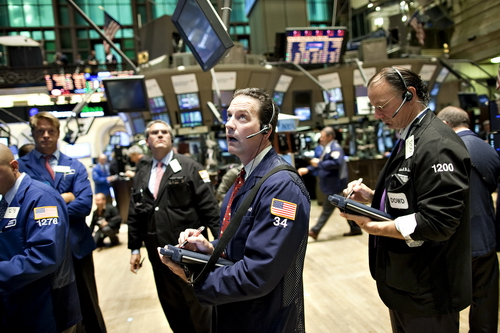World Business
SEC to probe huge plunge in stocks
By David Scheer (China Daily)
Updated: 2010-05-08 09:59
 |
Large Medium Small |
Investigation follows sell-off that briefly wiped out over $1 trillion
NEW YORK - US regulators plan to examine whether securities professionals triggered Thursday's stock-market plunge or exploited the turmoil to profit illegally, two people with direct knowledge of the matter said.
 |
|
Traders work on the floor of the New York Stock Exchange. [DANIEL ACKER / BLOOMBERG] |
The Securities and Exchange Commission aims to determine if market participants accidentally or maliciously entered orders that derailed normal trading, the people said, declining to be identified because the inquiry isn't public.
The agency will also examine if controls to prevent the rout from snowballing weren't in place at exchanges and firms.
SEC officials, who haven't drawn conclusions, began preparing for inquiries in the hours after a US sell-off triggered by Europe's debt crisis briefly erased more than $1 trillion in market value, beginning around 2:40 pm in New York. US stocks tumbled the most in a year as waves of computerized trading exacerbated the rout, sparking a slide in Asian shares.
The SEC and Commodity Futures Trading Commission said in a joint statement after US markets closed that they will examine "unusual trading" that contributed to the plunge.
"We will make public the findings of our review along with recommendations for appropriate action," they said.
SEC spokesman John Nester declined to comment on the investigations.
The regulator will also look at whether traders tried to take advantage of the chaos, such as by entering orders that drove some stocks to pennies, according to the two people.
New York Stock Exchange (NYSE) Euronext spokesman Ray Pellecchia said sudden price moves in multiple stocks reached so-called liquidity replenishment points, prompting the exchange to slow trading in those shares as it tried to ensure an orderly market. Such incidences allow other exchanges to ignore NYSE price quotes.
Larry Leibowitz, chief operating officer of NYSE Euronext, in an interview with Bloomberg Television, said: "If you look at the charts you can see fairly clearly where the trades came in."
"It's that V-shaped drop where it came down and snapped right back up. You had some very high-cap stocks trading down 50 percent or large percentages in a split instant because there really was no liquidity in electronic markets," he said.
NYSE spokesman Rich Adamonis said "there were a number of erroneous trades" during the slide. The Dow Jones index ended the session down 347.8 points, or 3.2 percent, to 10,520.32 at the close of trading.
| ||||
Nasdaq OMX Group Inc said 286 securities that rose or fell more than 60 percent during the stock-market's plunge will have trades canceled.
The exchange had no problems with its computer systems, spokesman Robert Madden said in a statement.
US Representative Paul Kanjorski, a Pennsylvania Democrat, set a May 11 hearing to examine what caused stocks to plunge.
He also sent a letter to SEC Chairman Mary Schapiro seeking the agency's views on the incident, and asked what authority the SEC has to prevent futures crashes.
Bloomberg News













